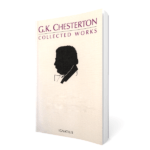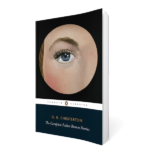It is no secret that the character of Father Brown was inspired by Fr. John O’Connor. Chesterton was intrigued by the fact that most people do not take priests seriously, thinking them out of touch with the grime and crime of the real world. It never occurs to them that a man who hears confessions might have some insight into the dark recesses of the human soul.
Confession is about telling secrets, telling what we don’t want anyone to know. But these are not secrets to be kept. They must be gotten rid of. They must be forgotten. They must be absolved. There is only one way to do that.
This is the fourth of five collections of Father Brown stories. It was dedicated to that real priest who first enlightened Chesterton about the sacrament of Confession, and who was himself the inspiration for the character of the cleric who solved crimes. “To Father John O’Connor,” wrote Chesterton in the dedication, “whose truth is stranger than fiction, with a gratitude greater than the world.” It is a gratitude the whole world still shares.
This is perhaps the most intriguing set of Father Brown stories, as we meet “The Man with Two Beards,” and hear “The Song of the Flying Fish,” and discover “The Worst Crime in the World.” These are mysteries that look into the deepest mystery of the soul itself, exploring the nature of sin, of confession, of forgiveness. But besides that, they are rattling good yarns. In fact, the story that deals most extensively with confession is also the tale that has been called by one respected critic the best mystery story ever written: the Gothic-like “Chief Mourner of Marne.”
There is one other element that sets this collection apart. It includes a prelude and a postlude, a scene of Father Brown visiting Flambeau in later years. The former thief and former detective and former sidekick of the priest has married and retired to a mountain estate in the Spain. The two of them are being interviewed by an American reporter, who asks the questions we would like to ask, but doesn’t get the answers we expect. The answers, of course, are the stories themselves. Full of secrets. Full of surprises.
We learn that Father Brown has a niece and that he is her guardian. We learn that he is very fond of strong Protestants because he knows they will tell the truth. We discover, perhaps not surprisingly, that one of his heroes is Pope Leo XIII. We find out, also not surprisingly, that he’s very partial to anything that is brown. But the most intriguing revelation of all is that somewhere in this collection – we won’t say where – Father Brown makes his own startling confession about how he solved the most puzzling murders: “You see, it was I who killed all those people.”
If that line does not startle you, perhaps you should check your pulse.
The priest’s methods are anything but modern, we might say anything but scientific. A criminologist attempts to get outside of the criminal and study him like a giant insect. Father Brown does just the opposite. He tries to get inside the criminal. “You may think a crime horrible because you could never commit it. I think it horrible because I could commit it.”
Understanding the motive for the crime is more important than understanding the mechanics. Understanding the motive means understanding sin. Sin destroys. It destroys from within. That is why it is horrible. It does its work in the dark. The wildest crimes, Father Brown tells us, are not the worst. It is the cold and calculated ones that are most horrifying, committed by the man who lives only for this world, who believes that his success and pleasure are the only important things, or even worse, who will do anything to save his respectability.
Most sin involves being small-minded. Forgiveness involves being large-minded, that is, generous. Father Brown points out that most of us pardon only those sins that we don’t think are sins. The priest does not have that comfortable option. But Father Brown’s great sympathy comes from never forgetting that he, too, is a sinner. “I don’t care for spiritual powers much myself. I’ve got much more sympathy with spiritual weaknesses.”
And yet before the forgiveness is the sad discovery of the sin. In one scene Chesterton describes his famous detective as wearily laying down his famous umbrella as a pilgrim might lay down his staff, and having “an air of some depression…It was not the depression of failure, but the depression of success.” Solving the crime is never a pleasure for the priest. But seeing sinners forgiven is always a joy for him.
We want the criminal caught and punished. Father Brown wants his soul to be saved. When one character protests to the priest: “But he is a convicted thief!” the little cleric gently reminds him that it was a convicted thief who is the only person “who has ever in this world heard that assurance: ‘This night shalt thou be with Me in Paradise.’”


